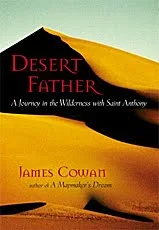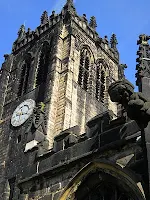Today at
Saint Paul's Episcopal Church in Chattanooga, TN, I led an Adult Education class on desert spirituality. Originally the class was to take place at the start of Lent, but scheduling conflicts caused me to move towards the end. Knowing that it was a big topic and time a significant factor, I plowed ahead to do the best that I could do.
For a long time, I have wanted to teach spirituality and contemplative prayer in the Episcopal Church. I have long felt impoverished in my own upbringing in the faith by a serious lack of Christian education in this important area for discipleship. Needless to say, one class on a Sunday morning only begins to scratch the surface. Alas, I was grateful for the opportunity to broach the subject.
The basis for the class was a reading of Henri Nouwen's The Way of the Heart, a primer for contemplative prayer by gleaning from the life of the fourth century desert mothers and fathers. Here are some of my notes. The page numbers refer to my copy of Nouwen's book (New York: Seabury Press, 1981).
___________________________________________________
A Brief Overview of Desert Spirituality
The Christian life has its many trials and temptations. We struggle in our daily lives with the temptations for better jobs, material possessions and wealth, and the ultimate pursuit of happiness. The culture today shares this with the late Roman world of the fourth century.
With the toleration of Christianity under the Edict of Milan in 313, the narrow door that Jesus spoke of was flung far and wide, opening the gates to thousands of new Christians. The Church no longer faced bloody persecution from Rome. With this peace and growth came a prevailing sense that the Christian standard was deteriorating, the faith was becoming too common and lapsed, so it seemed.
Monasticism appears on the scene in the fourth century as an impulse to reform the church from the relaxed standards of the Christian life. Subversive to the culture of material wealth and power, life for the desert fathers and mothers was a search for solitude in the wilderness of Egypt to find a deep, abiding union with God in Christ. Their testing was to renounce the world's priorities in search of the richness of Christ founded upon a strict dedication or rule of life.
Nouwen's The Way of the Heart
In classic Nouwen form, The Way of the Heart presents five short chapters with straight-forward reflective insights into the spiritual tradition that grew out of the desert in the fourth century. It is a misreading of Nouwen, here, to see the interior life and growth through silence apart from ministry within the Kingdom of God. Nor, however, is this implying or espousing the Platonic ideals of mind/body dualism, or the Manichaeism heresy.
Desert spirituality is quite clearly a primer for discipleship which Our Lord calls and invites us all to live. The result of desert spirituality in practice is a well-spring of compassion, a capacity so widened by transforming silence that we are able to bear one another's crosses in solidarity with Jesus Christ.
Class Outline
I. Opening Silence and Prayer
II. Overview of Desert Spirituality
· flee, be silent, and pray, the three main ideas of desert spirituality.
III. Prologue
· What is required of us as ministers of the Gospel in our day (pg. 12)
· Subversive Prayer, the actions of the desert fathers and mothers subverted the established culture
· Romans 12:1-2 "I appeal to you therefore, brothers and sisters, by the mercies of God, to present your bodies as a living sacrifice, holy and acceptable to God, which is your spiritual worship. Do not be conformed to this world, but be transformed by the renewing of your minds, so that you may discern what is the will of God—what is good and acceptable and perfect."
· New kinds of martyrs, witnesses against the destructive powers of evil and witnesses for the transforming power of Christ.
IV. Solitude
· Thomas Merton (p.21)
· Society as molding us for seductive powers
· Take a look at our own weekly routine in order to see our priorities
· Two main enemies of the Spiritual life: anger and greed
· The Furnace of Transformation
· "My soul 'too cramped for you to enter it--widen it out." St. Augustine's Confessions
· Jesus' Temptations in the desert
· Matthew 9:9-13 "As Jesus was walking along, he saw a man called Matthew sitting at the tax booth; and he said to him, ‘Follow me.’ And he got up and followed him. And as he sat at dinner in the house, many tax-collectors and sinners came and were sitting with him and his disciples. When the Pharisees saw this, they said to his disciples, ‘Why does your teacher eat with tax-collectors and sinners?’ But when he heard this, he said, ‘Those who are well have no need of a physician, but those who are sick. Go and learn what this means, “I desire mercy, not sacrifice.” For I have come to call not the righteous but sinners.’"
· Dying to the false self
· Spirituality and Ministry meet in compassion
V. Silence
· Have words lost their power? Is language our only ability to communicate with God?
· What value does our culture place on silence?
· What value does our worshipping community place on silence?
· What would our lives look like without distractions? What would our ministry look like?
· "Silence is the home of the word." Nouwen
· "God's first language is silence, everything else is translation" Thomas Keating
· John 1:1-5 "In the beginning was the Word, and the Word was with God, and the Word was God. He was in the beginning with God. All things came into being through him, and without him not one thing came into being. What has come into being in him was life, and the life was the light of all people. The light shines in the darkness, and the darkness did not overcome it."
· Vincent van Gogh (p.55)
VI. Prayer
· How does silence manifest itself in prayer?
· How does this square with community prayer and worship?
· "Arrow Prayers" (p.80)
· Via Negativa or the Apophatic tradition























